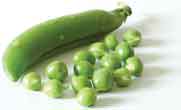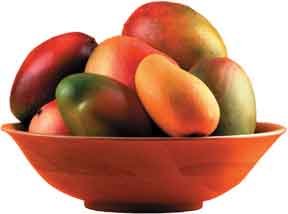Meena Raghunathan
 Here is a questionnaire that you have to get two people to answer: your mother or father; and your grandmother or grandfather (or someone their age). Fill the first two columns. Then ponder over the answers and fill your own thoughts in the third column.
Here is a questionnaire that you have to get two people to answer: your mother or father; and your grandmother or grandfather (or someone their age). Fill the first two columns. Then ponder over the answers and fill your own thoughts in the third column.
| Mother/father | Grandmother/Grandfather | My thoughts | |
| Are there any fruits and vegetables today that you did not have when you were young? Could you name them? | |||
| Are there any fruits and vegetables that you ate when you were young that we do not see today? Could you name them? | |||
| Which were the costliest fruits and vegetables when you were young? Are they still the costliest? | |||
| Were there some seasonal vegetables/ fruits which are now available through the year? | |||
| Is the rice we eat the same that you used to eat when you were young? | |||
| Which cooking oils used to be commonly used when you were young? | |||
| When you compare the flavour and taste of food when you were my age and now, what do you feel? |
We depend on nature for our food. ‘Domesticated biodiversity’ is the basis of all our food. This big term only means the variety and range in the plants and animals that humans have domesticated for their purposes. For instance, it is the number of different varieties of rice or mustard or potatoes or buffaloes that humans have developed over the centuries. Today, hundreds of these varieties are disappearing. From your own survey with your parents and grandparents, you would have realized this.
But is that a matter of worry? Yes indeed!!! Why?
Humans have worked hard to develop these different varieties. Each of the varieties has its own special characteristics. For instance, there are some rice varieties which are long and fragrant and therefore useful for certain dishes like pulaos; others which are sticky and short and used in kheer. Some which grow at higher altitudes, some which grow in plains. Some are purple, some are red, and some are white. There are some which can withstand flooding. Some which have special nutritional qualities. In fact, it is estimated that at one time India had over 100,000 varieties of rice! All this is the result of ingenuity of the farmers. It has taken them long years to breed these varieties. Wouldn’t it be a tragedy to lose all this?
 Once these are lost, they are lost forever. Who knows when we will need a quality that one of these strains harbours?
Once these are lost, they are lost forever. Who knows when we will need a quality that one of these strains harbours?
Biodiversity is not just about disappearing tigers and forests! Biodiversity is disappearing from our farms and kitchens too! Let us do something about it.
- Try to find out more about the variety of Indian crops and livestock. You will be surprised at what you discover! India has an immense richness of both. In fact, we are blessed with the richest livestock diversity in the world: 26 breeds of cattle, 40 of sheep, 20 of goats, 8 of buffalo and 18 of poultry.
- Organic is good. Excessive use of pesticides and fertilizers endangers soil and indirectly, the biodiversity. Try to persuade your family to add organic foods to the shopping list.
- It’s not just rice and wheat. Our agriculture has very nutritious staples like jowar, bajra, ragi, and many other millets and grains. Try them all!
- Try to shop for local fruits and vegetables.
- And, grow your own! Have a kitchen garden. Plant local fruit trees. You will love the fruits of your labour!
Mango mazaa
Here is a word search – and yes, you guessed right! You have to find the names of 10 varieties of mangos hidden in the maze. And the prize if you find all 10 – well, a mango maybe? Or since it is not the season, mango jelly!
| B | E | N | E | S | H | A | N | U | T |
| A | K | A | J | U | B | V | P | K | O |
| J | M | U | J | P | J | A | A | N | T |
| L | U | R | U | M | A | N | I | D | A |
| G | P | A | I | R | I | R | R | G | P |
| R | F | S | L | F | Y | A | I | W | U |
| L | A | N | G | R | A | J | R | Y | R |
| P | J | E | H | A | N | G | I | R | I |
 In case you are stumped, check out this list. All the ten are from this larger list of 68 mango varieties (Source: http://www.festivalsofindia.in/mango/Varieties.aspx). And this is just a miniscule portion of the 1000 varieties of mango we have in the country. If you haven’t heard of or tasted many of them, set yourself this as a task for the next summer! Each of these is typical to a specific part of the country, so why don’t you get in touch with friends and family in other parts and ask them what mangoes they have, and what is so special about them?
In case you are stumped, check out this list. All the ten are from this larger list of 68 mango varieties (Source: http://www.festivalsofindia.in/mango/Varieties.aspx). And this is just a miniscule portion of the 1000 varieties of mango we have in the country. If you haven’t heard of or tasted many of them, set yourself this as a task for the next summer! Each of these is typical to a specific part of the country, so why don’t you get in touch with friends and family in other parts and ask them what mangoes they have, and what is so special about them?
1) Taimoorlang, 2) Husnaara, 3) Aabehayat, 4) Zawahiri, 5) Dussheri, 6) Chosa, 7) Lucknowi, 8) Langra, 9) Neelum, 10) Rumani, 11) Alphonso, 12) Bombay Green (Sarauli), 13) Banganpalli, 14) Samar Behest Chausa, 15) Fazli, 16) Kishenbhog, 17) Himsagar, 18) Gulabkhas, 19) Zardalu, 20) Airi, 21) Malkurad (Goa), 22) Kesar, 23) Rajapuri, 24) Jamadar (Gujarat), 25) Beneshan, 26) Bangalora, 27) Suvarnarekha, 28) Mulgoa, 29) Raspuri, 30) Badami, 31) Allampur Beneshan, 32) Himayuddin, 33) Jehangir, 34) Cherukurasam, 35) Bathua, 36) Bombai, 37) Sukul, 38) Fernandin, 39) Mankurad, 40) Vanraj, 41) Mundappa, 42) Olour, 43) Pairi, 44) Safeda, 45) Raspoonia, 46) Mithwa Sundar Shah, 47) Mithwa Ghazipur, 48) Taimuriya, 49) Sharbati Begrain, 50) Gilas, 51) Nauras, 52) Rasgola, 53) Hardil-aziz, 54) Peddarasam, 55) Totapuri, 56) Kothapalli Kobbari, 57) Chinna Rasam, 58) Pedda Rasam, 59) Mallika, 60) Ratole, 61) Kaju, 62) Himayat, 63) Khatta Meetha, 64) Panchadara Kalasa, 65) Manjeera, 66) Amrapali, 67) Arkapuneet, 68) Sindhu
The author is Director (Community Services) at GMR Varalakshmi Foundation. She has been writing for teachers and children for over two decades. She can be reached at Meena.Raghunathan@gmail.com.
